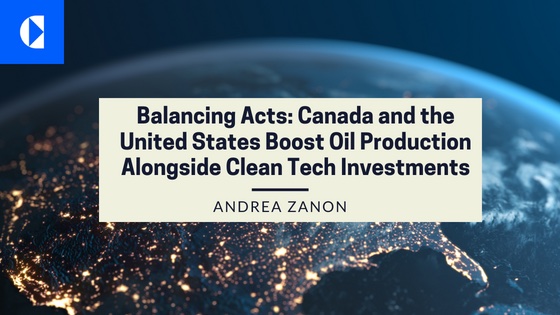As of 2023, both countries have increased their oil and gas production, reaching record targets and profits. In December 2023, the US became the largest oil producer globally, with 13.5 million barrels of oil produced per day. In early 2024, Canada produced 4.9 million barrels per day, becoming the fourth-largest oil producer behind the US, Saudi Arabia, and Russia (Financial Post). Both countries are expected to hit new records in 2024, with 14 million bpd and 5.4 million bpd, respectively. The top-listed oil and gas producers in the US reported a combined net income of $313 billion in the first three years of President Biden’s term, three times the $112 billion generated during the same period under President Trump (Financial Times). In Canada, oil and gas corporations are also producing record revenues.
What is happening to Canada and US Climate Leadership?
While the politics of oil and climate are colliding, we should expect more green growth investment from both countries. In the US, the Inflation Reduction Act (IRA) is expected to generate US$1.2 trillion in clean tech investment, including cross-border renewable energy projects, carbon capture, and electric battery investments. In Canada, companies like Pathways have proposed a $16 billion carbon capture project, the largest in the world. Its first phase can be executed only with Canadian government financial support, addressing some financial risks. While these are not nearly enough to correct US and Canada carbon intensive economies, they are positive longer-term efforts to decarbonize North America.
The Market Shift
At the end of 2023, during COP 28, hosted by the UAE, the 7th largest oil producer in the world, the International Energy Agency Managing Director stated, “The Clean Tech transition is unstoppable”. To illustrate this statement further, investments in clean energy and technologies surpassed investment in fossil fuels in 2023 (IEA Energy Outlook 2023). Globally, over US$3 trillion was invested in energy in 2023, with more than USD 1.8 trillion invested in clean technologies, including renewables, electric vehicles, nuclear power, efficient grids, storage, low-emission fuels, and heat pumps (IEA 2023). This investment shift is influenced by geopolitical concerns and energy market shocks, pushing nations to prioritize energy security and reduce reliance on politically motivated fossil fuels suppliers such as Russia. There are also strong policy incentives such as the IRA and the EU Green Deal to incentivize business to invest in decarbonization projects.
Canadian Efforts and Stats (in Canadian dollars)
According to the Canadian Government, the country’s climate investment gap is $120-140 billion annually to reach Net zero by 2050. Corporate Knights estimates 80% of the climate mitigation investment (roughly $126 billion per year) should come from the private sector by 2030. At a macro level, Canada has prioritized 470 large green-growth projects for an estimated investment of $520 billion. These projects are either planned or under development over the next 10 years, with 183 projects utilizing clean technology, representing potential investments of $116 billion.
On the Venture Capital (VC) front, Canada is leading in clean tech ventures, despite a global decline in VC investments since 2021. With only 0.5% of the global population, Canada ranked fifth among nations for cleantech investment between 2021 and Q3 2023, surpassing the U.S., China, U.K., and Germany (Crunchbase). The average investment was higher than global, with investment appetite geared towards growth companies such as Eavor, OMV, OYA Renewable, and CarbonCure, companies that have secured VC funding in the 71-200 million dollars range. This positive momentum is a strong signal of Canada’s commitment to sustainability and clean energy in the startup space.
Conclusion: In the short term, both Canada and the US seek to maximize their oil and gas natural resources, and in so doing, become the energy suppliers of choice. This is particularly important during this time of geopolitical tension in Central Asia and in the Middle East, where both countries are helping stabilize energy markets addressing EU supply deficits. As this materializes, the US will leverage its Inflation Reduction Act to subsidize its own transition to a less carbon intensive future and attract hundreds of billions of clean tech investment. Canada will follow suit to ensure that its oil and gas revenues are reinvested towards the green transition and thus meet the Net-Zero decarbonization targets by 2050.

